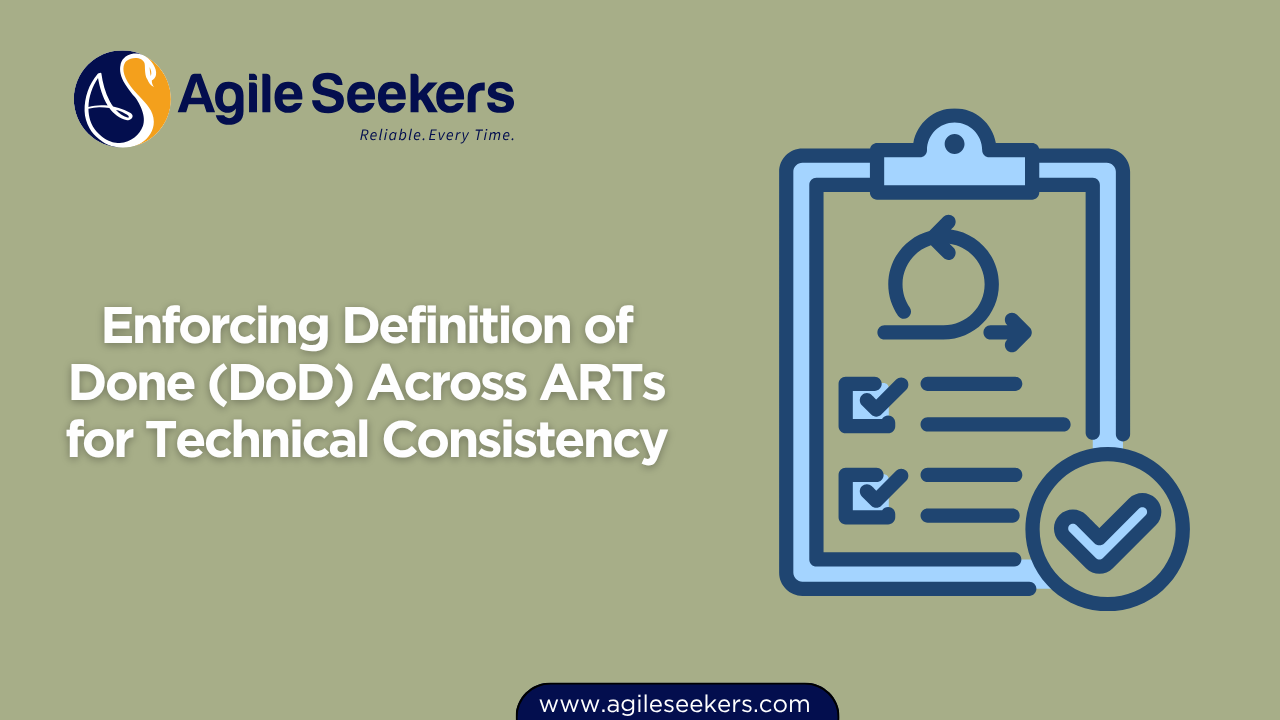Enforcing Definition of Done (DoD) Across ARTs for Technical Consistency

Achieving technical consistency across Agile Release Trains (ARTs) in SAFe is no accident—it demands a shared understanding of quality. One of the most powerful levers Product Owners and Product Managers can use is the Definition of Done (DoD). Yet, applying the DoD across multiple teams in an ART—and especially across multiple ARTs—requires more than a checklist. It requires shared ownership, alignment with architecture and compliance standards, and continuous reinforcement through leadership, coaching, and tooling.
In this article, we’ll explore how to enforce a consistent DoD across ARTs, the role of leadership and architecture in shaping it, and how it ultimately contributes to the reliability, security, and scalability of SAFe implementations.
What Is the Definition of Done (DoD) in SAFe?
Within the SAFe POPM Certification context, the Definition of Done refers to a shared agreement on the quality criteria a work item must meet before it can be considered complete. It spans multiple layers—from user stories and features to capabilities and epics. In a SAFe environment, the DoD often addresses:
- Unit and integration test coverage
- Security and compliance standards
- Performance benchmarks
- Documentation and NFRs (non-functional requirements)
- Code review and architectural alignment
While each Agile team might define their local DoD, ART-level and Solution Train-level consistency ensures interoperability, regulatory adherence, and system-level quality.
Why Consistency in DoD Across ARTs Matters
When multiple ARTs collaborate on a solution, inconsistency in quality standards can quickly lead to:
- Integration failures
- Undocumented edge cases
- Security vulnerabilities
- Varying code quality and performance bottlenecks
Having a unified DoD across ARTs creates a baseline of expectations for every team, making it easier to scale continuous delivery and maintain a resilient architecture.
Establishing a Baseline Definition of Done
Creating a baseline DoD begins with identifying mandatory quality criteria. Collaboration between Release Train Engineers (RTEs), System Architects, Business Owners, and Product Managers is essential. Start by answering:
- What testing and security protocols are non-negotiable?
- What documentation is required before release?
- What integration standards must be met?
Consider using the DoD template provided in the SAFe Framework’s DoD reference and tailor it to your solution domain.
Steps to Enforce DoD Across ARTs
1. Align DoD With Architectural Standards
The DoD must align with system-level architecture decisions. In SAFe, System Architects play a key role in ensuring architectural runway and NFRs are baked into the DoD. If multiple ARTs interact with shared components, architectural guardrails should inform the shared DoD.
2. Use Communities of Practice (CoPs)
Establish a Definition of Done Community of Practice composed of lead engineers, Product Owners, and Scrum Masters across ARTs. They can define, evolve, and socialize the DoD in a collaborative space. This also helps propagate engineering best practices horizontally.
3. Implement DoD Enforcement Through Tooling
Agile management tools like Jira, Rally, and VersionOne can automate DoD compliance. For instance, mandatory fields (e.g., test cases linked, documentation uploaded, security checks passed) can be enforced via workflow states and pull request templates.
DevSecOps practices, especially continuous compliance tooling like SonarQube for code quality and OWASP Dependency Check for vulnerabilities, can integrate directly into CI/CD pipelines and enforce DoD adherence.
4. Audit and Coach with Inspect and Adapt
During Inspect & Adapt (I&A) sessions, use System Demos and retrospectives to audit adherence to the agreed DoD. Metrics such as code coverage, NFR fulfillment, and bug counts post-PI can inform whether the DoD is effectively enforced.
Product Managers certified through the SAFe Product Owner/Manager certification are expected to guide teams in aligning quality with business value. Coaching them on enforcing DoD helps bridge the technical-business divide.
Scaling DoD Across Solution Trains
At the Solution Train level, consistency becomes even more critical. Capabilities spanning multiple ARTs must meet uniform acceptance criteria. Here, the Solution Architect and Solution Train Engineer (STE) help define capability-level DoD, ensuring technical alignment across the broader value stream.
This DoD should include:
- System-wide regression coverage
- Interoperability testing
- Security risk mitigation steps
- Business continuity and SLA readiness
Ensuring this through layered reviews and pre-release checklists adds robustness to large solution development.
Role of SAFe POPM in Upholding DoD
One of the key responsibilities taught in SAFe POPM Training is maintaining product quality through alignment with technical enablers and Definition of Done. A certified SAFe Product Owner ensures that every feature and story includes DoD considerations upfront during backlog refinement.
This includes collaborating with System Architects on enablers, coordinating with Release Management, and making sure that test automation, documentation, and compliance criteria are reflected in the acceptance criteria.
Common Pitfalls and How to Avoid Them
- Team-level variations: Teams customizing DoD without coordination leads to inconsistency. Solution: Create a layered DoD—team-specific additions on top of a shared baseline.
- Ignoring technical debt: Teams skip DoD criteria under time pressure. Solution: Make DoD non-negotiable and visible in Definition of Ready (DoR) as well.
- Manual checks: Relying on human review alone causes delays. Solution: Use automated CI/CD gates that block incomplete stories or features.
Conclusion: A Shared Commitment to Quality
When teams across ARTs share a clear and enforceable Definition of Done, it creates a backbone of technical quality that supports delivery at scale. Enforcing it requires more than policy—it demands commitment from leadership, active engagement by Product Owners, architectural oversight, and automated guardrails.
Investing in SAFe-aligned training like the SAFE Product Owner/Manager certification helps ensure those enforcing the DoD understand its business and technical implications.
Done right, a unified DoD enables faster integration, fewer production issues, and a sustainable pace of development. In scaled Agile environments, consistency isn't a constraint—it’s the foundation of speed and quality.
Also read - Using Innovation and Planning (IP) Iterations for Technical Spikes
Also see - Managing Feature Toggle Strategies in SAFe Continuous Delivery Pipeline




















